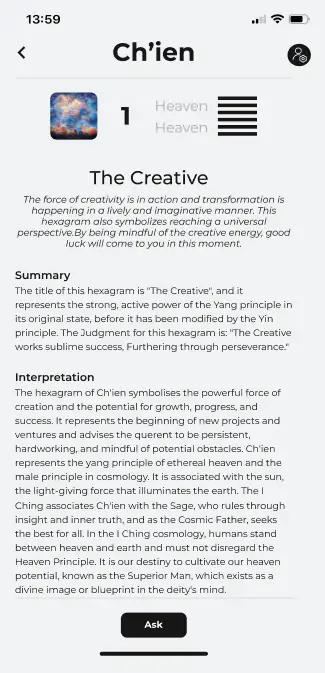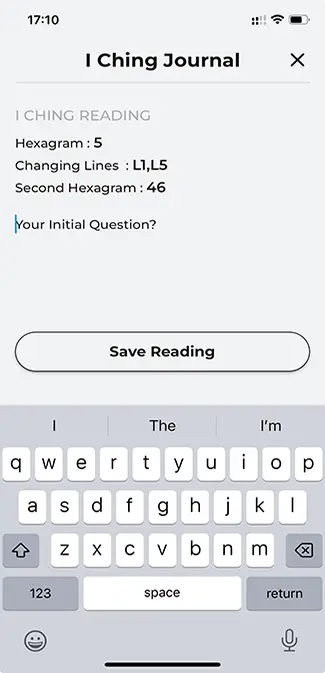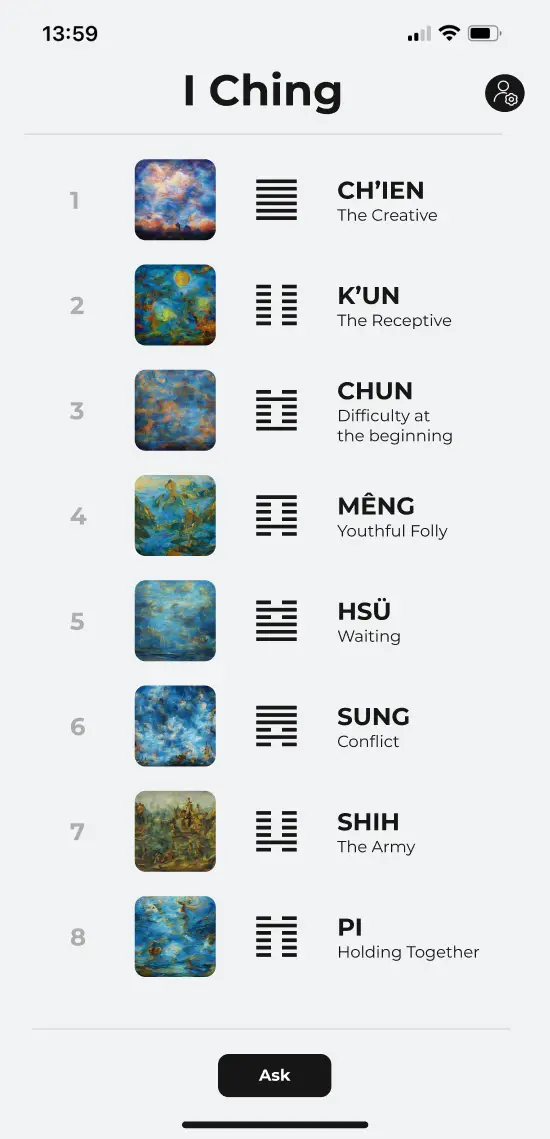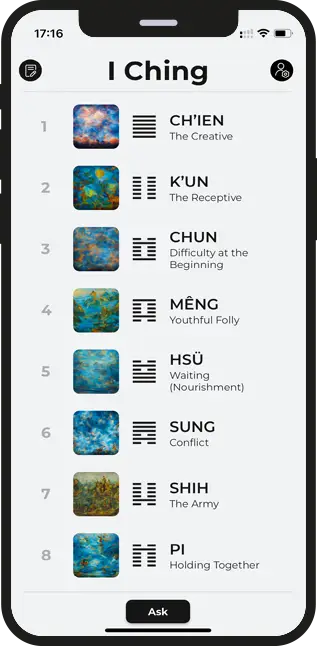
Water
Mountain
Hexagram 39 - Obstruction - CHIEN
To overcome an obstruction, we need to change our perspective, as we often perceive the situation as worse than it is. By adopting a positive attitude, the obstacle can be resolved. When we feel surrounded by obstructions, it is best to take a step back and seek the guidance of a trusted advisor or the wisdom of the Sage.
Summary
The central theme of Hexagram 39 is obstruction, both in terms of physical blockages and mental or emotional obstacles. The key takeaways from the Judgment and image are the importance of perseverance and determination in overcoming obstacles and the importance of being flexible and adaptable to find new solutions or paths forward.
Interpretation
Represents obstacles, blockages, and hindrances in one's path. The image of the mountain standing in the way of progress or movement can be seen as a symbol of external, physical obstructions or internal blocks and resistance that one may face in their journey. It is a reminder that progress and development often require overcoming obstacles and resistance, whether physical, social, or psychological. One should persevere and remain determined in the face of obstacles. It encourages individuals to maintain a steady and unswerving attitude, to be persistent and not give up in the face of difficulties. This is a call to be patient and have faith in the process rather than focusing solely on the end goal.
The imagery and advice can also be interpreted as a reminder to be adaptable and flexible, to explore new solutions and paths instead of getting stuck in one way of thinking. It emphasises the importance of staying open-minded and willing to learn, examining one's thinking, and being receptive to the advice of others.
When faced with obstacles, it is easy to become discouraged or frustrated. However, Hexagram 39 teaches us that obstacles and challenges are a natural part of life and should not deter us. Instead, it is essential to have the perseverance and determination to overcome them and learn from the experience. It encourages individuals to embrace the challenge and to see it as an opportunity for growth and self-improvement.
The advice can also be applied to interpersonal relationships. When we often indulge in judgments about others, we obstruct our peace of mind and progress. Hexagram 39 encourages us to choose instead to see the best in others, to allow them to come and go as they will, and to turn our energies inward toward self-improvement. It reminds us to be patient and understanding with others, let go of our ego and be receptive to their needs and perspectives.
Some experts may interpret this hexagram as an indication that the querent is in a state of stagnation and facing obstacles preventing them from achieving their goals. They may suggest that the querent needs to be more assertive and proactive to overcome these obstacles. Others may suggest that the querent needs to take a step back, reevaluate their goals, and consider alternative solutions.
Ultimately, Hexagram 39 teaches us that obstacles and hindrances are a natural part of life and that we should not allow them to discourage us or prevent us from achieving our goals. By persevering, staying open-minded, and remaining determined in adversity, we can overcome obstacles and emerge stronger and more resilient.
Sage Advice
Approach obstacles and difficulties with a learning and growth mindset. Rather than seeing obstacles as negative or hindrances, we should view them as opportunities for personal development and greater understanding. By facing challenges with patience, perseverance, and an open mind, we can cultivate resilience, wisdom, and a deeper appreciation for life's natural ebb and flow. It is also important to avoid blaming others or external circumstances for our obstacles and instead take responsibility for our attitudes and actions. By embracing obstacles as opportunities for growth, we can transform adversity into a catalyst for positive change and self-improvement.
Line 1
Advises us not to resist difficulties or obstacles but rather to retreat and wait for the right moment to act. Doing so allows us to gain a correct perspective and learn essential lessons from the situation. This may involve letting go of the impulse to figure everything out and taking defensive actions, instead allowing the situation to work itself out while being patient and persevering. The first line reminds us that obstacles and difficulties are a natural part of life and that we should not be discouraged by them. Instead, we should use these challenges as opportunities for growth and learning. By approaching the situation with patience, humility, and a willingness to learn, we can gain the insight we need to move forward and make progress. This can involve reframing our perspective and seeing the obstacle as a potential opportunity for growth rather than a roadblock to our goals.
Line 2
Advises us not to blame ourselves for the difficulties we may be facing. It is easy to point fingers and blame others for the obstructions we encounter, but we must remember that not all adversity is our fault. However, we must also remember not to impose Judgment or penalize others for their faults. Instead, we should focus on doing what is correct and just. It is essential to accept the situation for what it is and not to let our ego create an unpleasant outcome. Letting go of judgments and forgiving those who may have transgressed creates an opportunity for growth and development. The line emphasises the importance of cultivating a just and moderate view of transgressions and letting go of the desire to supervise or measure others' progress. We should not prevent others from changing by imposing our will upon them but rather allow them to find their way. By doing so, we create growth opportunities and avoid the possibility of "lawsuits" and "wars" caused by our subconscious thoughts. This line also advises us to trust the Sage, who knows how to make the impossible succeed and not to give up on our goals. In summary, the second line teaches us to let go of blame, Judgment, and fear and to focus on doing what is correct and just.
Line 3
Warns against acting recklessly and egotistically when facing obstructions. It advises retreating and restoring one's equanimity, as good fortune will follow. The line suggests that when we encounter obstacles, it's important not to rush headfirst into action but to take a step back and reassess the situation. In doing so, we may find that the obstruction is not necessarily a hindrance but rather an opportunity for growth and development. By refraining from egotistical demands and expectations of others, we allow them the freedom to find their way and make their own decisions. By cultivating inner stillness and detachment, we open ourselves to possibilities beyond our immediate perceptions. Ultimately, by letting go of our ego and following the guidance of the Sage, we can overcome any obstacle and achieve success.
Line 4
The best way to move forward is to remain patient and wait for the right opportunity. The line advises that even though our intentions may be noble, we cannot rely solely on our intellect or logical reasoning to overcome our challenges. Instead, we must seek the guidance and support of trustworthy companions, which could come from within ourselves or our external environment. To do this, we must be willing to step back and allow time to work its magic. We must avoid being impulsive or overly reactive to obstacles and instead focus on persevering with calm determination. This may require us to withdraw from internal conflicts or external pressures inhibiting our progress. By gathering our inner resources and remaining still, we become more attuned to the subtle cues and opportunities that arise. We can then move forward with greater clarity and purpose, with the assurance that we are on the right path. Ultimately, the fourth line reminds us that progress is not always linear or straightforward and that we must be willing to adapt and evolve in response to the challenges we encounter.
Line 5
Emphasises that even in the most challenging situations, help and support can arrive from unexpected sources. The Sage, in particular, can come to our aid when we remain steadfast in doing what is right and refrain from becoming defensive. By maintaining a sense of openness and sincerity, we can awaken sensitivity and clarity in others who may have previously seemed closed off or uncooperative. These "friends" may be the key to overcoming our obstacles, but we must cultivate a sense of trust and cooperation with them. Ultimately, the strength of our principles and our willingness to persevere and remain steadfast in the face of difficulty will determine our success in overcoming obstructions.
Line 6
Urges us to embrace our inner greatness and not turn away from the challenges we face, even when it seems difficult or hopeless. The line warns against indifference and a lack of faith in our ability to effect change. We must take action and seek the guidance of the Sage to deal with obstacles and emerge victorious. By embracing our inner strength and perseverance, we help ourselves and those around us who may be depending on us. This line highlights the importance of taking responsibility for our actions and stepping up as a leader, even in adversity.








